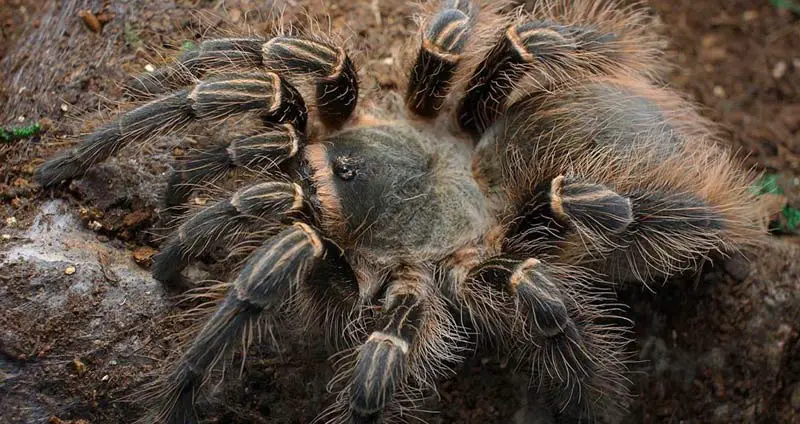If you’re a beginner to tarantulas and you’re looking to break into the hobby, doing so can be pretty challenging. With well over 800 types of tarantulas known today, there’s practically an endless supply of tarantulas to choose from!
However, any experienced tarantula keeper will tell you that all tarantulas are not made equal. Some are great for beginners, while others are extremely dangerous and should only be kept by professionals.
This post will detail the 10 best pet tarantulas for beginners, taking into account many different factors.
Tarantula keeping is relatively simple, but only if you start off slow and learn a lot as you go. The tarantulas listed below will keep care requirements to a minimum and allow you to become comfortable with the hobby.
Table of Contents
What Defines A “Beginner” Tarantula?
As stated, there are hundreds of different tarantula species out there. What separates these tarantulas from the rest as “excellent beginner tarantula species”?
Several factors go into this classification, actually! A beginner tarantula should have a healthy mix of the 5 characteristics highlighted below:
- Easy to care for– While (most) tarantulas are small, some can be exceedingly difficult to care for! There are some species that require very specific temperatures, humidities, enclosure setups, and feeding schedules. A beginner tarantula has very simple care requirements and thrives in conditions that aren’t exactly what they’re used to in nature. Essentially, most of these tarantulas will be terrestrial species.
- Docile – Another very important aspect of beginner tarantulas is how docile or friendly they are. If you’re inexperienced, you wouldn’t want a tarantula that’s willing to flick their urticating hairs or inflict a devastating bite. This limits your selection to only new world tarantulas, as old worlds are much more aggressive.
- Moderately-sized – Tarantulas come in all different shapes and sizes. However, as a beginner, you’ll want a tarantula that’s quite average in size. Extremes at both ends of the spectrum are harder to care for. Smaller tarantulas are more fragile, while larger tarantulas require larger, more complex setups. Around 5″ or 6″ is optimal for your first tarantula.
- Easy to source – It certainly helps if your tarantula is easy to find! There are some great tarantulas out there, but for whatever reason they’re not being bred frequently. This makes them difficult to find, and you don’t want to be looking around constantly for your first tarantula.
- Cheap to purchase – As your introduction to the hobby, you likely don’t want to spend hundreds of dollars on an exotic tarantula. Not only is this hard to justify for a beginner, but it can also add unnecessary stress. When an $800 tarantula is dependent on you and you’re not very experienced, keeping it may feel more like a job than a joy!
When you’ve found a tarantula that lives up to the standards listed above, chances are that you’ve found a great species for beginners. Using these standards, we’ve listed the 10 best (in our opinion).
Top 10 Beginner Tarantulas
The list of tarantulas mentioned below was compiled after a decent amount of research. While their adherence to the standards listed above was certainly a large aspect, we also considered the opinions of other tarantula owners.
You can’t really know how suitable a tarantula would be for beginners without living with it for yourself! Therefore, owner feedback is extremely important.
Additionally, while the tarantula species below are ordered, that order is just personal opinion. All of the species are excellent for beginners, so consider each one individually and ponder how its needs and personality conform to what you’re looking for.
So, without further ado — let’s get into the 10 best tarantulas for beginners!
10. Brazilian Salmon Pink Tarantula
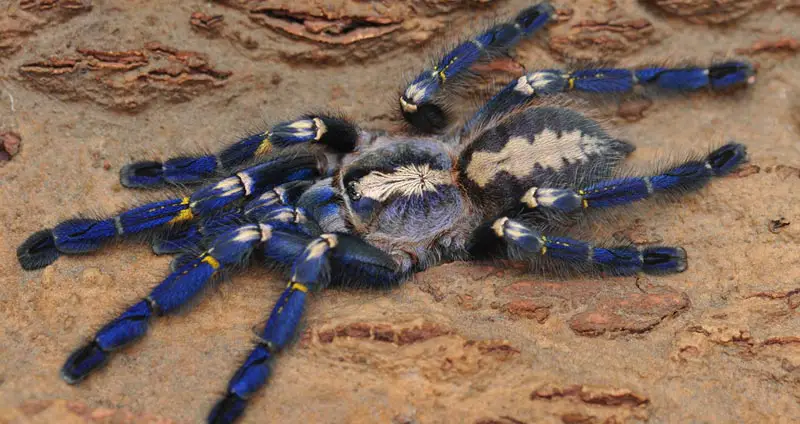


Lasiodora parahybana – Starting off with a doozy of a tarantula! This species has a fat brown body with salmon pink hairs entirely covering it. It’s also quite huge, with a max legspan of 10″!
Don’t less this intimidating appearance put you off, though, as this species is a sweetheart. It’s very slow-moving, docile, and prefers to run from confrontation as opposed to fighting back.
Additionally, it spends a lot of time out and about, so it’s great as a display tarantula that you get to admire frequently.
If you’re looking for a beginner tarantula but want something large and intimidating, Lasiodora parahybana is the way to go!
9. Greenbottle Blue Tarantula
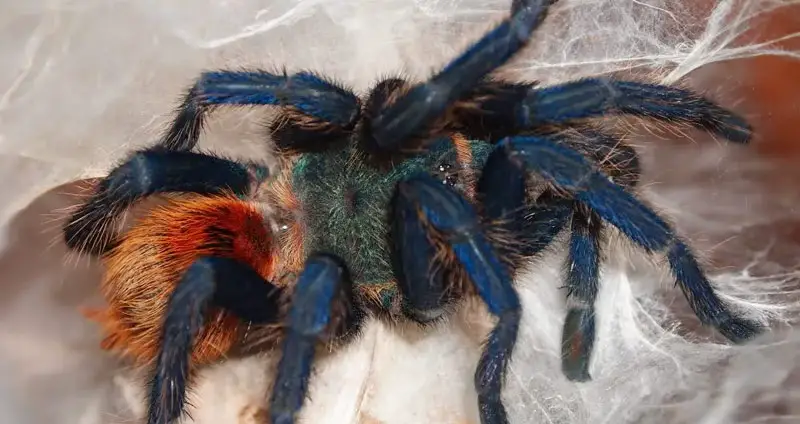
Chromatopelma cyaneopubescens – As far as friendly beginner tarantulas go, you won’t find one more attractive than the Greenbottle Blue tarantula! This species has a bright orange abdomen, greenish-blue carapace, and brilliant blue legs.
While it has a beautiful and frankly intimidating appearance, it’s great for inexperienced keepers. Aside from the fact that it’s a manageable 5″ in size, it’s also very docile and a notably hardy species.
There are optimal temperatures and humidities that C. cyaneopubescens should be kept at, but it will be more than fine in slightly sub-optimal conditions.
It’s also excellent for display as it’s a ravenous eater, always sitting out, and loves to create very intricate webs.
8. Purple Pinktoe Tarantula
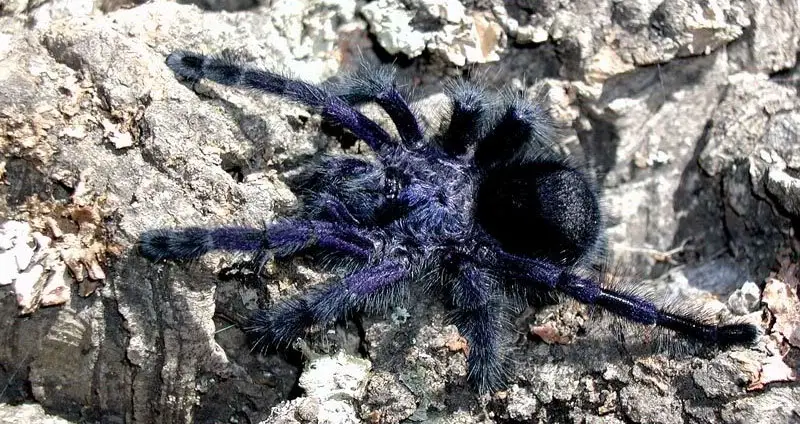
Avicularia purpurea – Avicularia is an arboreal genus, so its care is a bite more complicated, but you can’t deny how good the Purple Pinktoe tarantula is for beginners.
This species has a beautiful purple appearance that isn’t very common in other species, so it’s a great display species. On top of that, it’s very laid-back and docile, and is frequently handled by its keepers without any problems.
While it does require an arboreal setup, which is slightly more complicated than terrestrials, it’s still simple to meet all of its needs. Fully-grown females are also incredibly cheap, making them an affordable first tarantula.
7. Chilean Rose Tarantula
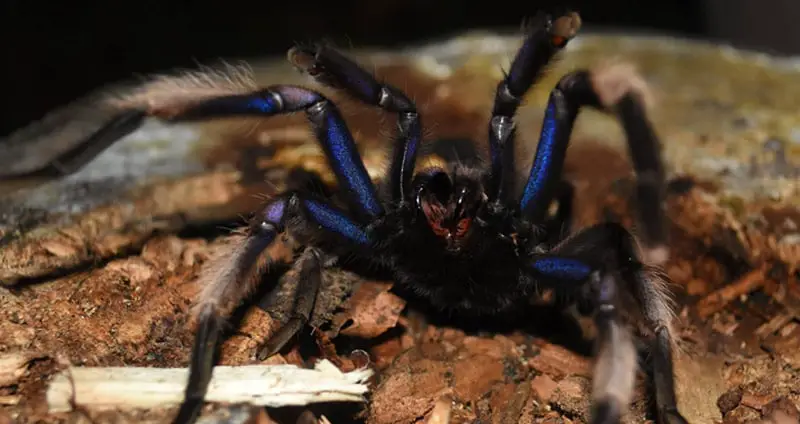


Grammostola rosea – One of the most longstanding beginner tarantula recommendations, the Chilean Rose tarantula is still a great first choice. It’s slow-growing, long-living, and kind of a jack of all trades.
Caring for this species couldn’t be easier. They only need an average-sized enclosure, dry substrate, a water dish, and a hide — that’s it! They’re incredibly hardy and adaptable and will reward you by staying out in the open for hours at a time.
G. rosea can also thrive in slightly colder temperatures, making it a great choice for people in colder climates.
6. Mexican Redknee Tarantula
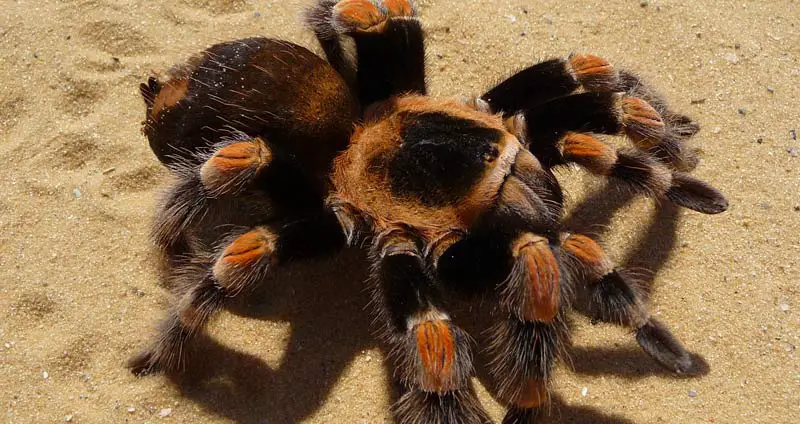
Brachypelma smithi – The Mexican Redknee tarantula is easily one of the most iconic and well-received tarantulas of all time. You’ll be hard-pressed to find someone not recommending this species for beginners.
Aside from its recognizable appearance, this tarantula grows into a very even-tempered, calm, and fun adult. You’ll get to experience a lot of this easy-going personality, too, as females can live up to 40 years!
Their enclosures can be simple, and they require very little maintenance. For beginners, while 40 years is a commitment, there are very few better tarantulas!
5. Chaco Golden Knee Tarantula
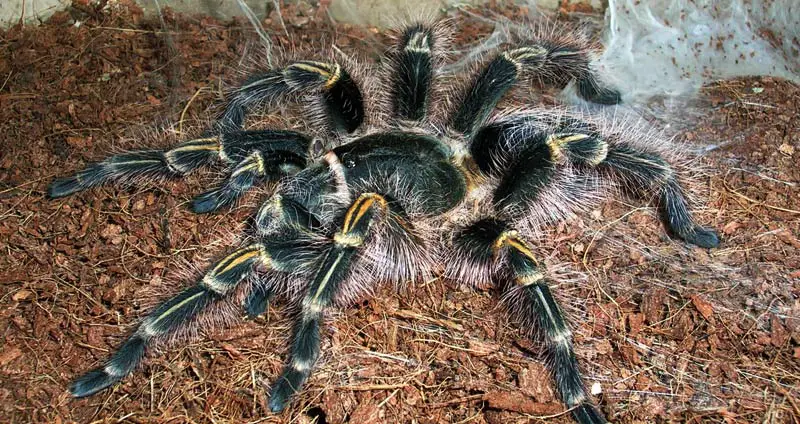
Grammostola pulchripes – Another tarantula from the Grammostola genus, the Chaco Golden Knee tarantula looks great and behaves even better. It’s dark-colored with rusty-brown accents all over its 8″-long body.
Care requirements for this species are very basic, and it will gladly sit on the top of its substrate all day long to show off for you. As spiderlings, they put on a display by constantly digging into and rearranging their substrate.
Much like other members of its genus, this species is very docile and friendly. Many owners like to handle theirs and don’t fear a bite or urticating hair flick.
4. Pinktoe Tarantula



Avicularia avicularia – This is easily one of the most recommended tarantulas whenever someone asks for beginner recommendations. The Pinktoe tarantula is popular, docile, cheap, and relatively easy to care for.
This is an arboreal species, so it does require a bit more of an intricate enclosure and it can be a bit sensitive to humidity, but nothing excessive.
Unfortunately, this tarantula has a shorter lifespan than many other species, but it’s a great tarantula to have during that time.
3. Pink Zebra Beauty Tarantula
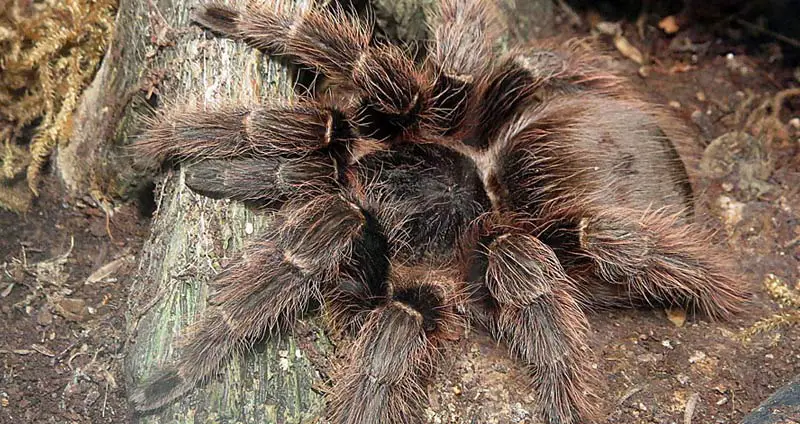
Eupalaestrus campestratus – In researching this tarantula, it seems that every single owner describes their Pink Zebra Beauty as a lovely docile creature. It’s as if this is the definition of a docile tarantula!
Owners never see their tarantula throw up threat poses or flick hairs, and they also state that its environmental needs are very easily-met.
On top of its ease of care, it’s a beautiful tarantula with a very cheap price tag, making it accessible for anybody that wants it.
2. Honduran Curly Hair Tarantula

Brachypelma albopilosum – The main driving force behind this tarantula’s popularity isn’t its calm disposition, but instead it’s great appearance!
This 6″, heavy-bodied tarantula is covered in dark brown hairs as a base, while tan and gold hairs that are characteristically curly sprout up all over. This gives it a fluffy and adorable appearance that makes it very approachable for beginners.
This cute appearance is backed up by a very friendly personality. The Honduran Curly Hair tarantula virtually never throws up threat poses, flicks hairs, or behaves negatively. Owners also love to handle them.
Their ideal enclosure is very simple and requires very little maintenance.
Overall, this is easily one of the best tarantulas for beginners.
1. Brazilian Black Tarantula
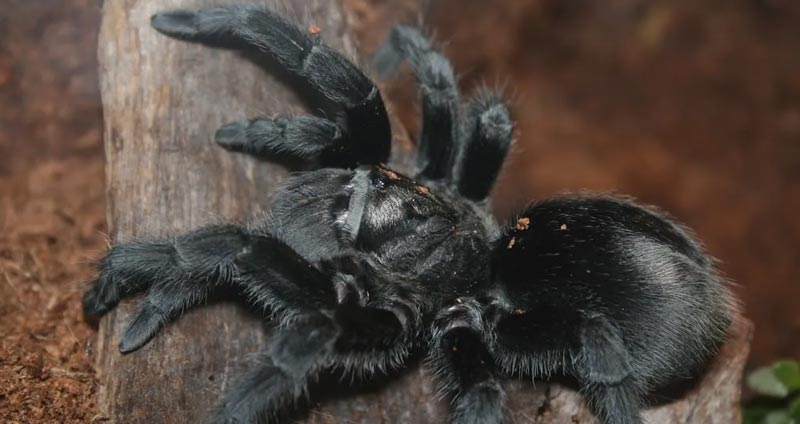
Grammostola pulchra – In our opinion, this is the best tarantula for beginners. Grammostola pulchra holds this title for several reasons.
To begin with, this tarantula just looks great. It’s entirely jet-black, shiny appearance makes it appealing for beginners and experienced keepers alike as it’s something that you don’t see very frequently.
Combine that coloration with up to 8 inches of legspan as an adult and this tarantula is a great display species!
In terms of temperament, this is a great species. It’s very slow-moving, friendly, and rarely ever gets defensive. It also spends most of its time above ground, so you’ll get to admire it frequently.
Unfortunately, this isn’t the most common tarantula, so it may not be available exactly when you’d like to purchase it. However, it does come up frequently, and it’s still very affordable compared to other species.
Additionally, females can live up to 30 years long! Such a long lifespan combined with a beautiful appearance and friendly temperament makes this the absolute best tarantulas for beginners in our opinion.
Conclusion
So, those are our picks for the top 10 tarantulas for beginners to the hobby. All of those would make an excellent first choice for someone that wants to get into tarantula keeping but doesn’t have a lot of experience or knowledge in general.
The tarantulas above are friendly, easy to get from most breeders, and very easy to care for. As a beginner, you can’t really ask for much more!
Which one of the tarantulas listed above is your favorite? Do you have it in your collection or hope to add it soon? Should we have included a species that we didn’t? Let us know in the comments below!

